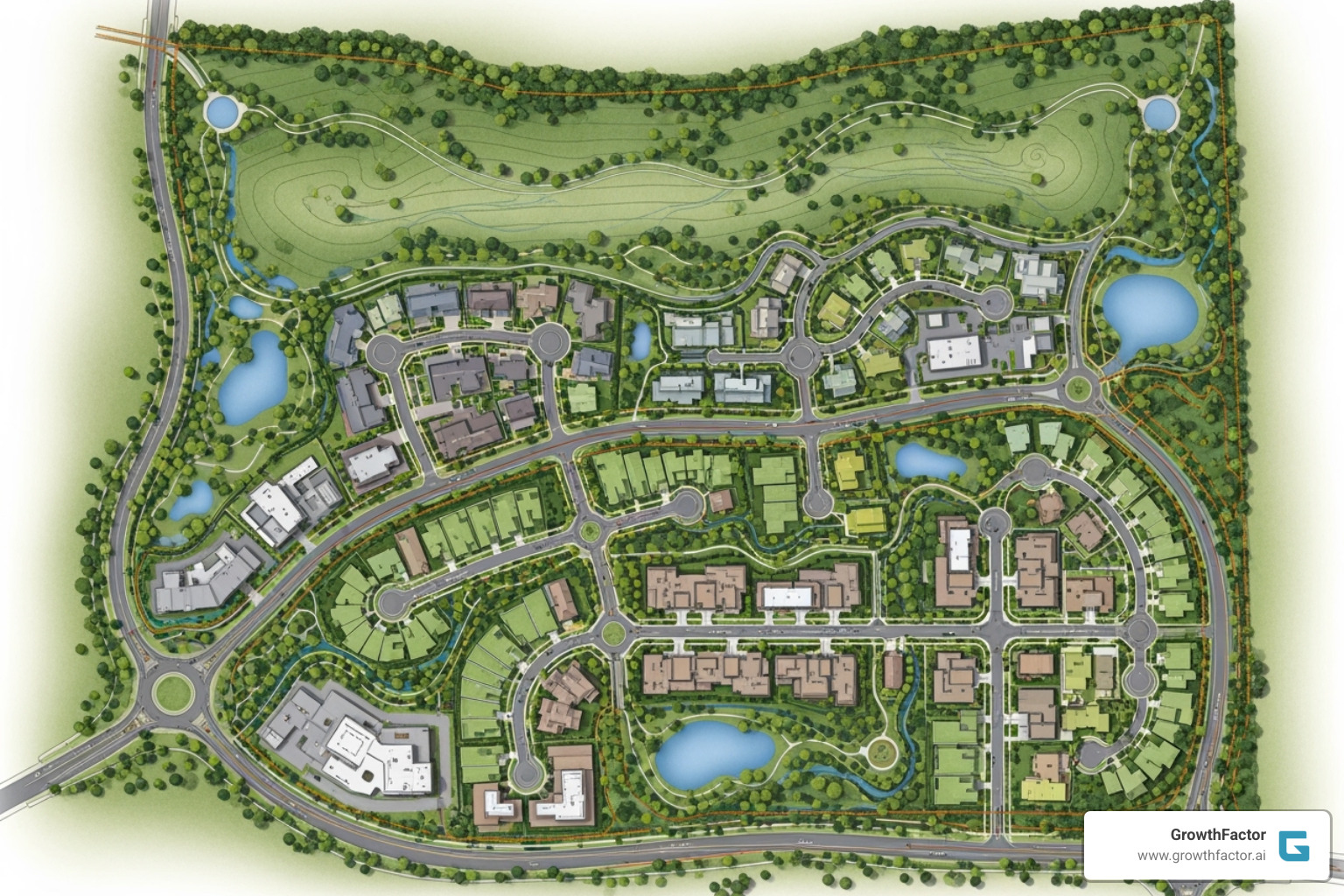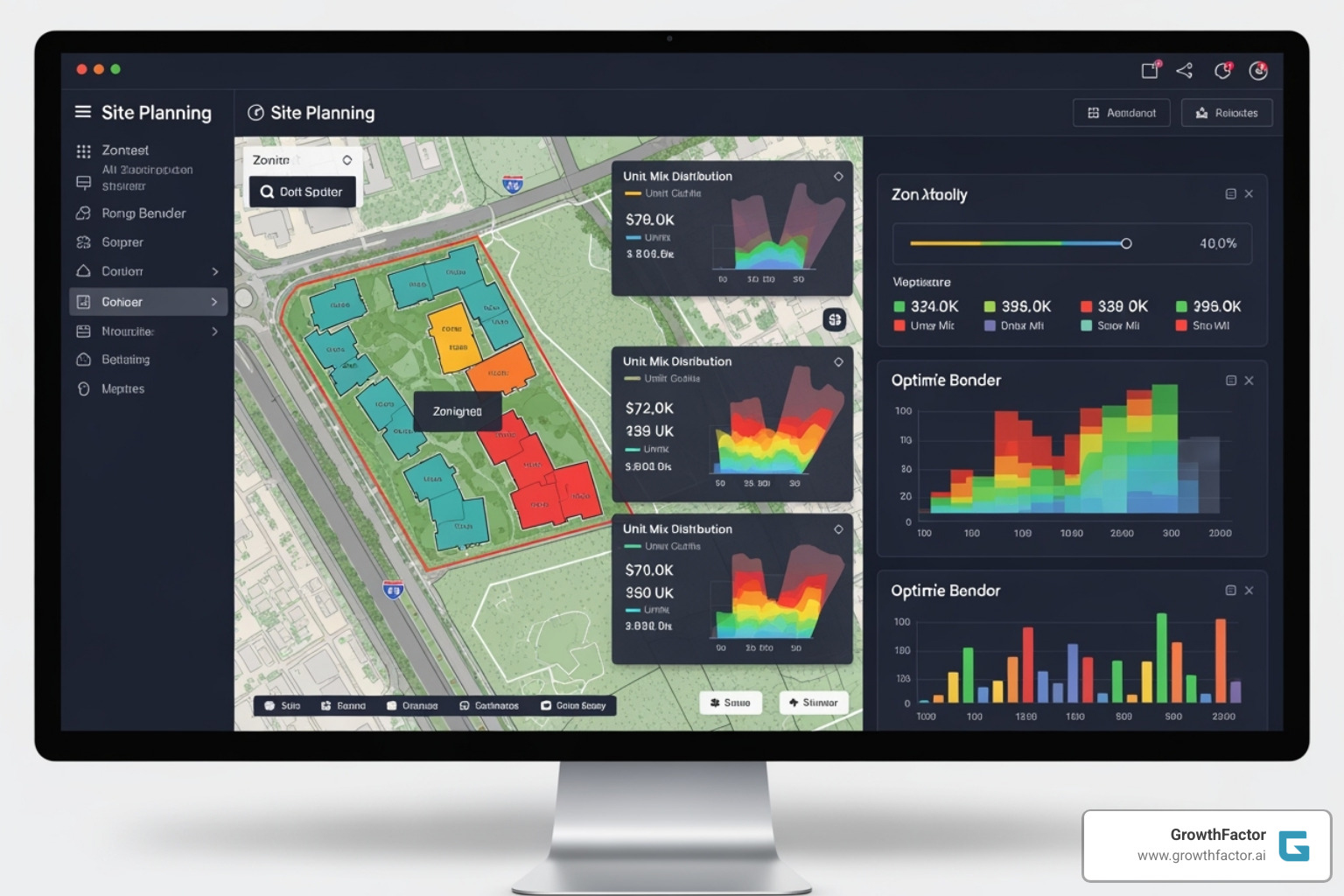How AI is Revolutionizing Site Planning for Real Estate
Why Site Planning is the Foundation of Every Real Estate Decision

Site planning is the strategic process of designing how a parcel of land will be developed. It organizes building placement, access, utilities, and landscaping to meet regulatory requirements and maximize a project's potential. Key components include property analysis, regulatory compliance, infrastructure design, stakeholder coordination, and financial validation.
Despite its importance, traditional site planning is a major bottleneck. The process requires weeks of revisions, costs thousands in fees, and leaves developers uncertain if a deal will pencil. A feasibility study might cost $50,000 and still not provide confident answers. For fast-growing chains evaluating dozens of locations, this slow, manual process means choosing between missing opportunities or risking costly mistakes.
This is where artificial intelligence changes everything. What once took weeks of revisions can now be done in hours for a fraction of the cost. Educated guesswork is replaced by data-backed certainty.
I'm Clyde Christian Anderson, and after a decade in retail real estate, I saw how manual processes held back expansion. I founded GrowthFactor to bring AI-powered intelligence to the site planning and selection journey, turning this bottleneck into a competitive advantage.

Site planning terms simplified:
The Fundamentals of Traditional Site Planning
Understanding traditional site planning highlights the change AI tools bring. For decades, developers used manual processes to turn raw land into functional developments. These foundations remain relevant, even as technology accelerates their application.
What is a Site Plan? (And Why It's Not a Floor Plan)
A site plan is a bird's-eye view of a property, showing where buildings will sit, how cars will move, where utilities connect, and how landscaping fits in. It's the master blueprint proving a project is both legally and practically sound.
Every developer needs one for regulatory approval. Local planning departments require a proper site plan demonstrating compliance with zoning, setbacks, and environmental standards before breaking ground. A good site plan also serves as a budgeting tool, revealing engineering and construction challenges like grading a steep slope or extending a sewer line. It acts as the common operating picture for the entire team—architects, engineers, and contractors all work from this roadmap.
Many confuse site plans with floor plans, but they are very different:
| Feature | Site Plan | Floor Plan |
|---|---|---|
| Scope | Exterior, macro-view, property-wide | Interior, micro-view, building-specific |
| Focus | How structures relate to land, surroundings, and infrastructure | Internal layout of rooms, walls, doors, and fixtures |
| Key Elements | Property lines, topography, landscaping, roads, parking, utilities, setbacks | Room dimensions, furniture placement, walls, plumbing, electrical outlets |
| Purpose | Regulatory approval, site organization, environmental integration | Spatial arrangement, interior functionality, user experience |
| Perspective | Bird's-eye view of entire property | Top-down view of a single building level |
A floor plan guides you inside a building; a site plan shows how that building connects to the world around it.
Essential Components of a Comprehensive Site Plan
Every complete site plan integrates multiple layers of information. Property lines and dimensions define the legal boundaries. Building footprints show existing and proposed construction. Setbacks and buffers ensure required distances from property lines and streets for light, air, and safety. Topography and contours reveal the land's slope and drainage, indicating where grading is needed.
Utilities map out water mains, sewer lines, and electrical conduits. Stormwater facilities detail detention basins or swales. Landscaping elements show preserved trees and new plantings. Parking and circulation details the traffic flow, including parking counts, accessible spaces, and emergency vehicle access. Easements mark areas with legal access rights for others. Finally, a north arrow, scale, adjacent streets, and zoning districts provide essential context.
For expert guidance on evaluating whether a site will work for your specific needs, explore our site evaluation services.
The Critical Role of Site Analysis
Before drawing a line, smart developers conduct site analysis—a comprehensive investigation to avoid costly mistakes and find hidden opportunities. This starts with understanding the location context, including adjacent properties and neighborhood character.
Next, you dig into topography and geology to understand slopes, soil conditions, and drainage, which drive foundation design and grading costs. Documenting existing structures and features helps decide what to preserve or remove. Checking infrastructure and utilities availability determines if the project is feasible without massive investment.
The regulatory environment—zoning, building codes, and environmental laws—must be understood early to prevent redesigns. Studying traffic patterns and access points is crucial for customer and delivery access. Finally, environmental factors like sun angles and prevailing winds influence building design and energy efficiency.
A comprehensive site analysis can turn constraints into advantages. A steep slope might offer dramatic views, and a wetland buffer can become a natural amenity. This research also reveals the human element, as our Site Demographics: The Complete Guide explains. Knowing the community helps you build better projects.
The Traditional Process: From Concept to Approval
Getting a site plan from idea to approval is a journey of patience. The traditional process involves countless meetings and revisions, often feeling like a maze of new requirements and unexpected delays.
A Step-by-Step Guide to the Planning & Approval Workflow
Every project begins with a concept, perhaps sketched on a napkin. This vision is then translated into a preliminary site plan by a civil engineer, who incorporates municipal codes and engineering standards.
Smart developers then schedule pre-application meetings with the local planning department to discuss key issues like stormwater, emergency access, and parking. This feedback can save months of revisions. Next, an investigative phase includes boundary and topographic surveys, environmental assessments, and soil studies to provide the factual basis for the plan.
This data informs the formal site plan submission, a package that must meet all local requirements. The municipal review process follows, where departments like planning, engineering, and fire safety examine the plan. For larger projects, public hearings may add time and uncertainty.

After addressing all concerns, you receive final approval, clearing the way for detailed design and construction. This entire process, as outlined in resources like the Chesterfield County Site Planning Process, can take weeks or months.
Navigating Key Challenges and Considerations
In reality, traditional site planning is filled with challenges that derail timelines and budgets.
Regulatory complexity is a major headache. Each municipality has its own rulebook for zoning, setbacks, and permits. A site that works in one jurisdiction may be unbuildable in the next. Environmental factors also demand attention, from protecting wildlife habitats and mature trees to managing stormwater in flood-prone areas.
The physical characteristics of a site, such as rocky soil or steep slopes, directly impact construction costs and feasibility. Poor water management can lead to flooding and erosion. Community impact cannot be ignored, as new developments affect traffic, pedestrian access, and neighborhood character. Managing stakeholder expectations requires clear communication and compromise.
Perhaps the biggest challenge is coordinating diverse professionals: architects, civil engineers, urban planners, landscape architects, and land surveyors. When these experts work in isolation, projects suffer from budget bloat and timeline slips. A well-coordinated site plan is the common operating picture that prevents these issues.
Understanding these challenges helps inform better Site Selection Criteria, steering you toward locations where obstacles can be managed and opportunities maximized.
The AI Revolution: Changing Site Planning for the Modern Era
For decades, site planning remained slow, expensive, and uncertain. CAD replaced drafting tables, but the core process didn't change. You'd still wait weeks for revisions and hope the numbers worked out.
Artificial intelligence is causing a fundamental shift, turning the slowest part of development into a competitive advantage.
How AI Accelerates Feasibility and Design Iteration
The most dramatic change AI brings to site planning is speed. Traditional methods meant waiting weeks for a single design iteration. If parking didn't fit or a setback was violated, you'd start over, costing time and money.
AI collapses this timeline from weeks to hours. A development manager told us, "I sat down one weekend and did a 65-acre development site plan in 3-4 hours... Before, it would take at least a week of back-and-forth revisions and cost us thousands of dollars."
AI also enables rapid prototyping and automated design, allowing you to explore more possibilities. Where $10,000 previously bought 15 building models, AI platforms can deliver 37. The technology excels at highest-and-best use analysis, rapidly testing different scenarios to find the optimal use for a site.

Modern AI platforms provide simultaneous 2D and 3D visualization, helping stakeholders intuitively understand the project and speeding up approvals. The productivity gains are staggering. One professional noted, "Now, with [AI], I can get the same job done in just 2 hours. That's the difference between me putting out 100 jobs a year versus 400+ a year." This efficiency opens up new business opportunities, with some firms winning over $750K in project fees due to this advantage.
Our AI Location Intelligence tools are designed to deliver exactly this kind of change.
Data-Driven Decisions and Financial Certainty
Speed is valuable, but the real power of AI in site planning comes from combining rapid iteration with data-backed financial certainty. Traditionally, you couldn't confidently answer "Will the deal pencil?" until late in the process.
AI flips this equation. Now you can validate pro formas against actual, generated layouts before design begins. Investment decisions are made with real data, not educated guesses. The technology also provides real-time cost estimation through automated takeoffs, calculating quantities for parking, earthwork, and other improvements for immediate cost insights.
One developer explained, "I can run the analysis quickly on what we find in the market and go to the investment committee with confidence knowing the deal will pencil or not." This confidence is key to allocating capital to the right opportunities.
Firms using AI-powered site planning have reported saving over $200,000 in labor hours and $90,000 per year on feasibility studies. These savings come from reducing time on viable projects and quickly vetting out bad deals.
This is the essence of Data-Driven Site Selection—making better decisions faster. AI doesn't replace human expertise; it amplifies it, freeing professionals to focus on strategy while the technology handles time-consuming work.
Avoiding Pitfalls and Embracing Best Practices
Even with AI, success in site planning isn't automatic. Technology can amplify good practices, but it can also amplify mistakes. Here are common pitfalls to avoid and best practices to accept.
Common Site Planning Mistakes to Avoid
The most expensive mistakes are often subtle. Poor graphic communication is a common error; a cluttered, confusing site plan damages credibility and slows approvals. Another mistake is treating site planning as a preliminary task to be rushed through. A thorough site plan is a strategic foundation, and ignoring its findings leads to costly changes later.
Ignoring comprehensive site analysis creates blind spots. Overlooking climatic factors, soil conditions, or local regulations for details like emergency vehicle access can derail projects. Similarly, overlooking specific municipal requirements for setbacks, buffer zones, or tree preservation can trigger immediate rejections, as rules vary widely between jurisdictions.
Finally, operating in silos is a persistent problem. When architects, engineers, and designers work independently, miscommunication is inevitable, leading to design conflicts and budget overruns that a unified site plan could have prevented.

Best Practices for Successful, AI-Improved Site Planning
Modern site planning practices, improved by AI, help avoid these pitfalls.
Integrate financial data early and continuously. AI allows you to validate pro formas against actual site layouts from day one, ensuring every design decision is made with financial viability in view.
Iterate rapidly and explore multiple options. Instead of committing to one direction early, AI lets you generate dozens of data-backed alternatives quickly, helping you find optimal solutions and secure client buy-in faster.
Use three-dimensional visualization. 3D views bridge the gap between technical drawings and stakeholder understanding, making presentations more persuasive and approvals faster.
Ensure proactive regulatory compliance. AI tools can integrate local zoning data, flagging potential compliance issues immediately so you can design solutions that meet all requirements from the start.
Collaborate effectively through integrated workflows. Modern AI platforms allow teams to push layouts to BIM software, export to CAD, and share live reports. This keeps the entire team aligned and reduces miscommunication.
Even with technology, clear communication is key. Use simple color schemes and clear visual hierarchy. Also, thorough site visits remain essential. AI processes data, but walking the property provides qualitative insights that databases miss—how water pools after rain, or how pedestrians actually move. This human insight, combined with AI's quantitative analysis, creates a complete picture.
These practices form a robust Site Selection Strategy that balances speed with thoroughness and technology with human insight.
Frequently Asked Questions about Site Planning
What is the difference between site planning and urban planning?
While related, they operate at different scales. Site planning is focused on the detailed design of a specific parcel of land—your project. It determines building placement, parking, and utilities for that single property.
Urban planning takes a wide-angle, city- or regional-level view. It involves developing strategic policies for land use, transportation, and community development. As "Site planning | landscaping" from Encyclopedia Britannica explains, urban planning provides the broad framework, while site planning designs the individual projects within it.
How much does a site plan typically cost?
Costs vary widely. Traditionally, professional fees for a complex commercial project can easily reach tens of thousands of dollars, with each revision adding to the total over a period of weeks.
AI-driven platforms are reshaping this cost equation. What once required a week and thousands in fees can now be done in hours. We've seen users create comprehensive site plans for large developments in a single afternoon. The savings are substantial, with some firms reporting a reduction of over $200,000 in annual labor hours. AI tools also allow for more design exploration for the same investment.
At GrowthFactor, our plans are designed to provide cost-effective ways to leverage AI for your site planning and feasibility work, delivering greater value and insight.
Who can legally prepare a site plan?
This varies by jurisdiction, but official site plans for permit approval must typically be prepared and certified by licensed professionals. These include:
- Licensed Civil Engineers for projects involving significant grading, drainage, or utility design.
- Licensed Architects when the focus is on building integration and design.
- Licensed Landscape Architects for projects with extensive landscaping and outdoor space design.
- Licensed Land Surveyors to provide the foundational boundary and topographic data.
For most commercial projects, the certification of these professionals is mandatory to ensure plans meet all technical, safety, and regulatory standards. Always consult your local planning department to clarify specific requirements.
Conclusion: The Future of Real Estate Development is Here
Site planning is the foundation that determines a development's success. Get it right, and a project is on the path to profitability. Get it wrong, and you face costly redesigns and missed opportunities.
For decades, this crucial phase was accepted as slow, expensive, and uncertain. Developers made decisions based on educated guesses rather than data-backed certainty.
But that era is ending.
Artificial intelligence is revolutionizing site planning. What took weeks now takes hours. Guesswork is being replaced by confident, data-driven decisions backed by real layouts and validated pro formas. Development teams are already generating more design alternatives, securing approvals faster, and walking into investment meetings with a level of financial clarity that was previously impossible.
At GrowthFactor, our AI-powered platform delivers this change. We provide the speed, accuracy, and financial clarity needed to win more profitable deals in a fast-moving real estate landscape. The developers who thrive will be those who can move decisively while others are still waiting on their first revision.
The future of real estate development is here. The only question is whether you'll lead the change or be left behind.
Ready to see what AI-improved site planning can do for your next project? Explore our expert-backed site evaluation services and experience the difference firsthand.
Citations
The human algorithm
Request Your demo
Schedule meeting
Or submit your information below and we'll be in touch to schedule.


